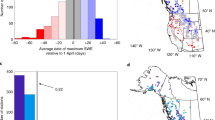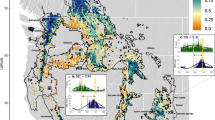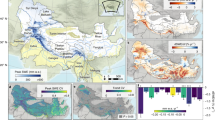Abstract
All currently available climate models predict a near-surface warming trend under the influence of rising levels of greenhouse gases in the atmosphere. In addition to the direct effects on climate—for example, on the frequency of heatwaves—this increase in surface temperatures has important consequences for the hydrological cycle, particularly in regions where water supply is currently dominated by melting snow or ice. In a warmer world, less winter precipitation falls as snow and the melting of winter snow occurs earlier in spring. Even without any changes in precipitation intensity, both of these effects lead to a shift in peak river runoff to winter and early spring, away from summer and autumn when demand is highest. Where storage capacities are not sufficient, much of the winter runoff will immediately be lost to the oceans. With more than one-sixth of the Earth's population relying on glaciers and seasonal snow packs for their water supply, the consequences of these hydrological changes for future water availability—predicted with high confidence and already diagnosed in some regions—are likely to be severe.
This is a preview of subscription content, access via your institution
Access options
Subscribe to this journal
Receive 51 print issues and online access
$199.00 per year
only $3.90 per issue
Buy this article
- Purchase on Springer Link
- Instant access to full article PDF
Prices may be subject to local taxes which are calculated during checkout



Similar content being viewed by others
References
The International Panel for Climate Change (IPCC) Climate Change 2001: The Scientific Basis (eds Houghton, J. T. et al.) (Cambridge Univ. Press, Cambridge, UK, 2001)
Barnett, T. P. & Pennell, W. (eds) Impact of global warming on Western US water supplies. Clim. Change 62 (Spec. Vol.) (2004).
Mote, P. W., Hamlet, A. F., Clark, M. P. & Lettenmaier, D. P. Declining mountain snow pack in western North America. Bull. Am. Met. Soc. 86, 39–49 (2005)
Dettinger, M. D., Cayan, D. R., Meyer, M. K. & Jeton, A. E. Simulated hydrologic responses to climate variations and change in the Merced, Carson, and American River Basins, Sierra Nevada, California, 1900–2099. Clim. Change 62, 283–317 (2004)
Hamlet, A. F., Mote, P. W., Clark, M. P. & Lettenmaier, D. P. Effects of temperature and precipitation variability on snow pack trends in the western U.S. J. Clim. (in the press)
Douville, H. et al. Sensitivity of the hydrological cycle in increasing amounts of greenhouse gases and aerosols. Clim. Dyn. 20, 45–68 (2002)
Giorgi, F., Whetton, P. H. & Jones, R. G. Emerging patterns of simulated regional climatic changes for the 21st century due to anthropogenic forcings. Geophys. Res. Lett. 28, 3317–3321 (2001)
Giorgi, F. & Bi, X. Regional changes in surface climate interannual variability for the 21st century from ensembles of global model simulations. Geophys. Res. Lett. 32, L13701, doi:10.1029/2005GL023002 (2005)
Ruiz-Barradas, A. & Nigam, S. IPCC's 20th century climate simulations: Varied representations of North American hydroclimate variability. J. Clim. (submitted)
Dai, A. Precipitation characteristics of eighteen coupled models. J. Clim. (submitted)
Cayan, D. R., Kammerdiener, S. A., Dettinger, M. D., Caprio, J. M. & Peterson, D. H. Changes in the onset of Spring in the Western United States. Bull. Am. Met. Soc. 82, 399–415 (2001)
Stewart, I., Cayan, D. C. & Dettinger, M. D. Changes in snowmelt runoff timing in Western North America under a ‘business as usual’ climate change scenario. Clim. Change 62, 217–232 (2004)
Nijssen, B., O'Donnell, G. M., Hamlet, A. F. & Lettenmaier, D. P. Hydrologic vulnerability of global rivers to climate change. Clim. Change 50, 143–175 (2001)
Liang, X., Lettenmaier, D. P., Wood, E. F. & Burges, S. J. A simple hydrologically based model of land surface water and energy fluxes for general circulation models. J. Geophys. Res. 99(D17), 14415–14428 (1994)
Vörösmarty, C. J. K. et al. The storage and aging of continental runoff in large reservoir systems of the world. Ambio 26, 210–219 (1997)
Vörösmarty, C. J. et al. Anthropogenic sediment retention: Major global impact from registered river impoundments. Glob. Planet. Change 39, 169–190 (2003)
Adam, J. C., Clark, E. A., Lettenmaier, D. P. & Wood, E. F. Correction of global precipitation products for orographic effects. J. Clim. (in the press)
Center for International Earth Science Information Network (CIESIN). Socioeconomic Data and Applications Center (SEDAC): Gridded Population of the World, Version 3 (Columbia University and Centro Internacional de Agricultura Tropical, Palisades, New York, 2004); available at http://beta.sedac.ciesin.columbia.edu/gpw
Peterson, T. C., Golubev, V. S. & Groisman, P. V. Evaporation losing its strength. Nature 377, 687–688 (1995)
Chattopadhyay, N. & Hulme, M. Evaporation and potential evapotranspiration in India under conditions of recent and future climate change. Agricult. Forest Meteorol. 87, 55–73 (1997)
Thomas, A. Spatial and temporal characteristics of potential evapotranspiration trends over China. Int. J. Clim. 20, 381–396 (2000)
Golubev, V. S. et al. Evaporation changes over the contiguous United States and the former USSR: a reassessment. Geophys. Res. Lett. 28(13), 2665–2668 (2001)
Brutsaert, W. & Parlange, M. Hydrologic cycle explains the evaporation paradox. Nature 396, 30 (1998)
Lawrimore, J. H. & Peterson, T. C. Pan evaporation trends in dry and humid regions of the United States. J. Hydrometeorol. 1, 543–546 (2000)
Hobbins, M. T. & Ramirez, J. A. Trends in pan evaporation and actual evapotranspiration across the conterminous U.S.: paradoxical or complementary? Geophys. Res. Lett. 31, doi: 10.1029/2004GL019846 (2004)
Walter, M. T., Wilks, D. S., Parlange, J.-Y. & Schneider, R. L. Increasing evapotranspiration from the conterminous United States. J. Hydrometeorol. 5, 405–408 (2004)
Roderick, M. L. & Farquhar, G. D. The cause of decreased pan evaporation over the past 50 years. Science 298, 1410–1411 (2002)
Ohmura, A. & Wild, M. Is the hydrological cycle accelerating? Science 298, 1345–1346 (2002)
Wild, M., Ohmura, A. & Gilgen, H. On the consistency of trends in radiation and temperature records and implications for the global hydrological cycle. Geophys. Res. Lett. 31, doi: 10.1029/2003GL019188 (2004)
International Panel for Climate Change. Climate Change 2001: Impacts, Adaptation and Vulnerability (eds McCarthy, J. J. et al.) (Cambridge Univ. Press, Cambridge, UK, 2001)
Barnett, T. P. et al. The effects of climate change on water resources in the West: Introduction and overview. Clim. Change 62, 1–11 (2004)
Payne, J. T., Wood, A. W., Hamlet, A. F., Palmer, R. N. & Lettenmaier, D. P. Mitigating effects of climate change on the water resources of the Columbia River Basin. Clim. Change 62, 233–256 (2004)
Middelkoop, H. et al. Impact of climate change on hydrological regimes and water resources management in the Rhine basin. Clim. Change 49, 105–128 (2001)
Gan, T. Y. Reducing vulnerability of water resources of Canadian prairies to potential droughts and possible climatic warming. Wat. Res. Manag. 14, 111–135 (2000)
Burn, D. Hydrologic effects of climatic change in west-central Canada. J. Hydrol. 160, 53–70 (1994)
de Loë, R., Kreutzwiser, R. & Moraru, L. Adaptation options for the near term: climate change and the Canadian water sector. Glob. Environ. Change 11, 231–245 (2001)
Schwindler, D. W. The cumulative effects of climate warming and other human stresses on Canadian freshwaters in the new millennium. Can. J. Fish. Aquat. Sci. 58, 18–29 (2001)
Thompson, L. G. et al. Tropical glacier and ice core evidence of climate change on annual to millennial time scales. Clim. Change 59, 137–155 (2003)
Combes, S., Prentice, M. L., Hansen, L. & Rosentrater, L. Going, Going, Gone! Climate Change and Global Glacier Decline 1–6 (World Wildlife Fund Climate Change Programme, WWF Germany, Berlin, 2004)
Singh, P. & Bengtsson, L. Hydrological sensitivity of a large Himalayan basin to climate change. Hydrol. Process. 18, 2363–2385 (2004)
Singh, P., Jain, S. K. & Kumar, N. Estimation of snow and glacier-melt contribution to the Chenab River, Western Himalaya. Mount. Res. Develop. 17(1), 49–56 (1997)
Singh, P. & Jain, S. K. Snow and glacier melt in the Satluj River at Bhakdra Dam in the western Himalayan region. Hydrol. Sci. J. 47, 93–106 (2002)
Gao, Q. & Shi, S. Water resources in the arid zone of northwest China. J. Desert Res. 12(4), 1–12 (1992)
Hou, S. et al. Climatological significance of an ice core net-accumulation record at Mt. Qomolangma. Chin. Sci. Bull. 45, 256–261 (2000)
Chinese Academy of Sciences. China Glacier Inventory (World Data Center for Glaciology and Geocryology, Lanzhou Institute of Glaciology and Geocryology, Lanzhou, 2004); available from NSIDC User Services (nsidc@nsidc.org)
Meier, M. & Dyurgerov, M. Deciphering complex changes in snow and ice. Science 297, 350–351 (2002)
Singh, P. Effect of warmer climate on the depletion of snow covered area in the Satluj basin in the western Himalayan region. Hydrol. Sci. J. 48, 413–425 (2003)
Singh, P. & Kumar, N. Impact assessment of climate change on the hydrological response of a snow and glacier melt runoff dominated Himalayan river. J. Hydrol. 193, 316–350 (1997)
Liniger, H., Weingarten, R. & Grosjean, M. Mountains of the World: Water Towers for the 21st Century 1–24 (Mountain Agenda, Center for Development and Environment, Institute of Geography, University of Bern, Bern, 1998)
Mark, B. G. & Seltzer, G. O. Tropical glacier melt water contribution to stream discharge: a case study in the Cordillera Blanca, Peru. J. Glaciol. 49, 271–281 (2003)
Kaser, G., Georges, C., Juen, I. & Moelg, T. in Global Change and Mountain Regions: A State of Knowledge Overview (eds Huber, U. M., Bugmann, H. K. M. & Reasoner, M. A.) 185–196 (Springer, New York, 2005)
Mark, B. G. & Seltzer, G. O. Evaluation of recent glacier recession in the Cordillera Blanca, Peru (AD 1962–1999): spatial distribution of mass loss and climatic forcing. Quat. Sci. Rev. (in the press)
Francou, B., Vuille, M., Wagnon, P., Mendoza, J. & Sicart, J. E Tropical climate change recorded by a glacier in the central Andes during the last decades of the 20th century: Chacaltaya, Bolivia. J. Geophys. Res. 108, D54154, doi:10.1029/2002JD002959 (2003)
Mark, B.G. & Seltzer, G.O. in Global Change and Mountain Regions: A State Of Knowledge Overview (eds Huber, U. M., Bugmann, H. K. M. & Reasoner, M. A.) 205–214 (Springer, New York, 2005).
Vuille, M. & Bradley, R. S. Mean annual temperature trends and their vertical structure in the tropical Andes. Geophys. Res. Lett. 27, 3885–3888 (2000)
Vuille, M., Bradley, R. S., Werner, M. & Keimig, F. 20th century climate change in the tropical Andes: observations and model results. Clim. Change 59(1–2), 75–99 (2003)
Kaufman, Y. J., Didier, T. & Olivier, B. A satellite view of aerosols in the climate system. Nature 419, 215–223 (2002)
Ramanthan, V., Crutzen, P. J., Kiehl, J. T. & Rosenfeld, D. Aerosols, climate, and the hydrological cycle. Science 294, 2119–2124 (2001)
Kiehl, J. T., Schneider, T. L., Rasch, P. J. & Barth, M. C. Radiative forcing due to sulfate aerosols from simulations with the National Center for Atmospheric Research Community Climate Model, Version 3. J. Geophys. Res. 105, 1441–1457 (2000)
Krishnan, R. & Ramanathan, V. Evidence of surface cooling from absorbing aerosols. Geophys. Res. Lett. 29, 54–56 (2002)
Rosenfeld, D. TRMM observed first direct evidence of smoke from forest fires inhibiting rainfall. Geophys. Res. Lett. 26, 3105–3108 (1999)
Rosenfeld, D. Suppression of rain and snow by urban air pollution. Science 287, 1793–1796 (2000)
Borys, R. D., Lowenthal, D. H., Cohn, S. A. & Brown, W. O. J. Mountaintop and radar measurements of anthropogenic aerosol effects on snow growth and snowfall rate. Geophys. Res. Lett. 30(10), 45-1–45-4 (2003)
Givati, A. & Rosenfeld, D. Quantifying precipitation suppression due to air pollution. J. Appl. Met. 43, 1038–1056 (2004)
Hansen, J. & Nazarenko, L. Soot climate forcing via snow and ice albedos. Proc. Natl Acad. Sci. USA 101, 423–428 (2004)
Hansen, J. et al. Earth's energy imbalance: Confirmation and implications. Science 308, 1431–1435 (2005)
Acknowledgements
This work is a contribution from IDAG, the International Detection and Attribution Group jointly supported by NOAA and DOE. The gross domestic product data set was developed by the Center for International Earth Science Information Network (CIESIN) at Columbia University, New York, with funding from the National Aeronautics and Space Administration. This manuscript was improved considerably through the suggestions of D. Pierce and A. Gershunov.
Author information
Authors and Affiliations
Corresponding authors
Ethics declarations
Competing interests
Reprints and permissions information is available at npg.nature.com/reprintsandpermissions. The authors declare no competing financial interests.
Rights and permissions
About this article
Cite this article
Barnett, T., Adam, J. & Lettenmaier, D. Potential impacts of a warming climate on water availability in snow-dominated regions. Nature 438, 303–309 (2005). https://doi.org/10.1038/nature04141
Issue Date:
DOI: https://doi.org/10.1038/nature04141
This article is cited by
-
Quantifying the climate change impacts on the magnitude and timing of hydrological extremes in the Baro River Basin, Ethiopia
Environmental Systems Research (2024)
-
Evidence of human influence on Northern Hemisphere snow loss
Nature (2024)
-
Winter snow deficit was a harbinger of summer 2022 socio-hydrologic drought in the Po Basin, Italy
Communications Earth & Environment (2024)
-
Snow loss pinned to human-induced emissions
Nature (2024)
-
How does the climate change effect on hydropower potential, freshwater fisheries, and hydrological response of snow on water availability?
Applied Water Science (2024)
Comments
By submitting a comment you agree to abide by our Terms and Community Guidelines. If you find something abusive or that does not comply with our terms or guidelines please flag it as inappropriate.



